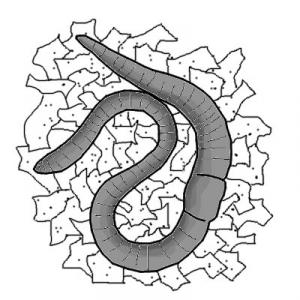Terra preta is the name of a carbon and nutrient rich soil, which has been produced by pre-Columbian cultures by the incorporation of manure, charcoal and bones into the grounds. Today, this concept has been rediscovered for the treatment of human faeces and household wastes (e.g. kitchen wastes). A promising application of terra preta sanitation (TPS) is the adaption of existing urine diverting toilets to replace the storage and dehydration treatment of urine and faeces. Terra preta sanitation (TPS) systems are based on a three-step process of collection (including urine diversion), lactic acid fermentation and vermicomposting. Lacto-fermentation is an anaerobic process, but in opposition to anaerobic digestion no gases are produced. The process thus is also odour free which makes it particularly interesting for in-house systems even in urban areas. TPS has a high potential to prevent nutrient or carbon loss to the atmosphere by producing highly fertile compost (terra preta) and liquid fertilizer for agriculture.
| Entradas | Salidas |
|---|---|
Blackwater, Faecal Sludge, Brownwater, Urine, Yellowwater, Faeces, Excreta, Organic Solid Waste |
Compost/Biosolids |
Terra preta is the name for the black and highly fertile soil that was produced by the pre-Colombian Amazonian cultures. Terra preta soils, literally “black earth”, contain higher concentrations of nutrients (such as nitrogen, phosphorus, potassium and calcium) and stable soil organic matter (SOM) than surrounding soils (GLASER et al. 2001).
According to archaeologists, pre-Columbian native populations generated them by incorporating large amounts of charred residues (charcoal) either produced intentionally or as a by-product from human activity into the soil together with nutrient-rich material (GLASER 2006). Nutrient-rich material was used to be human and animal manure (rich in P and N), waste including mammal and fish bones (rich in P and Ca), ash residues of incomplete combustions (rich in Ca, Mg, K, P and charcoal) or plant biomass (e.g. kitchen wastes, compost, algae etc.) (GLASER 2006). The addition of charcoal resulted in high contents of soil organic matter (SOM).
The black carbon content of terra preta soils can be up to 70 times higher than surrounding, mostly infertile, soils (GLASER et al. 2001), which gives these soils their black appearance and their amazing properties. Due to its polycyclic aromatic structure, black carbon is chemically and microbiologically stable and persists in the environment over centuries (GLASER et al 2001). Terra preta soils thus act as a long-term carbon sink (GUENTHER 2007).
A hectare of meter-deep terra preta can contain 250 tons of carbon as opposed to 100 tones in unimproved soil (GLASER et al. 2001; LEHMANN et al. 2006). Black carbon can be produced either by pyrolysis of biomass or by an enzymatic conversion of some microorganism (RECKIN 2010). It has a porous structure, which is good for the structure of the soil (water retention, aeration), the fertility of the soil and it increases growth rates and abundance of certain microbes, while abundance of fungi and germs is reduced:
Over the time, the black carbon is partly oxidised producing chemical molecules on its surface (carboxylic groups), which act as a trap for nutrients, preventing them from being washed out (GLASER et al. 2001). The nutrients entrapped like this in the porous structure of the charcoal provide necessary elements for plant growth, but also food and a safe housing to bacteria which are beneficial for the soil and plants (O'GRADY & RUSCH 2007, KIM et al. 2007).
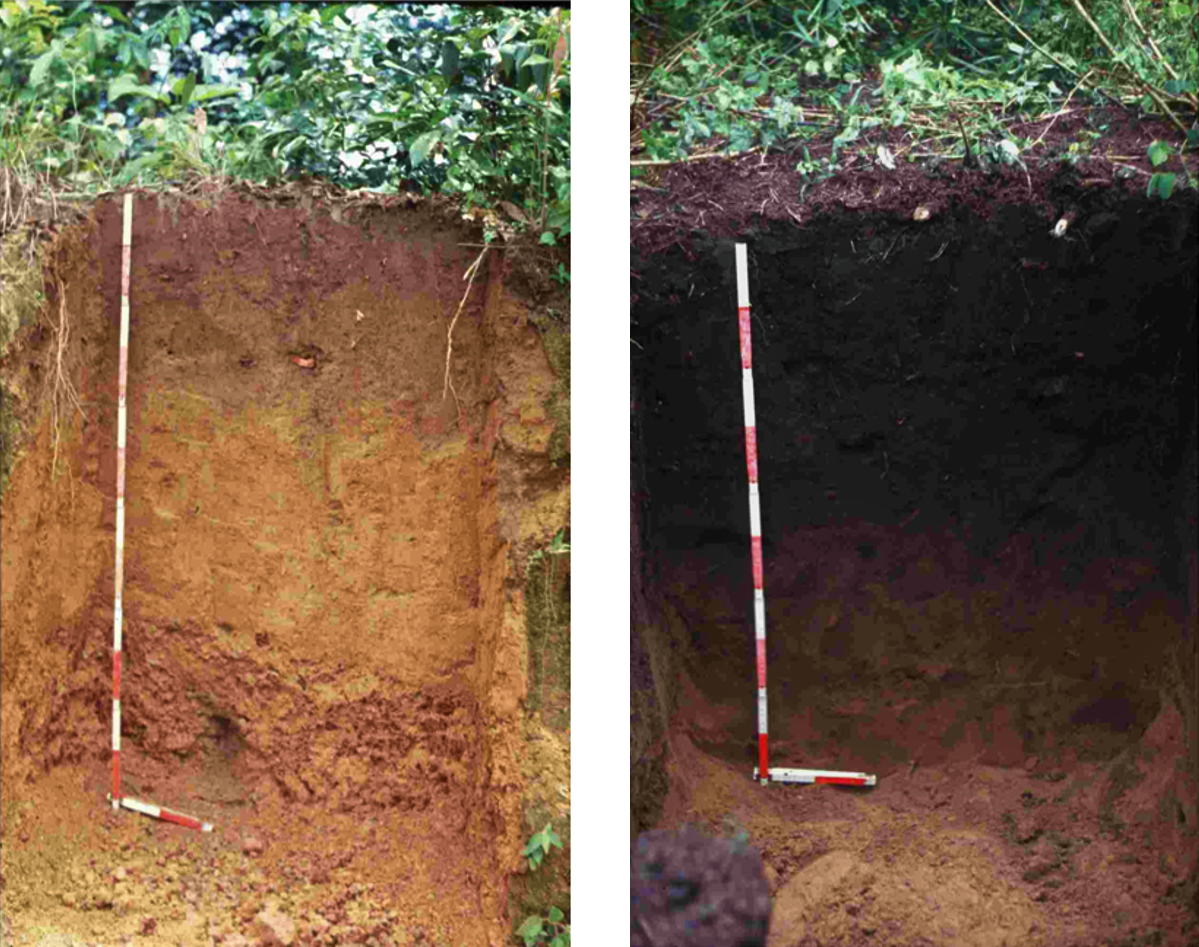
Today, it is argued that the generation of new terra preta (‘terra preta nova’) could be the basis for sustainable agriculture in the twenty-first century to produce food for billions of people, and could lead to attaining some major Millennium Development Goals: (i) to combat desertification, (ii) to sequester atmospheric CO2 in the long term, and (iii) to maintain biodiversity hotspots such as tropical rainforests (GLASER 2006).
This idea has been taken up in the recent years from sanitation experts, as terra preta seems to be a re-discovered, but today very promising response to the challenge of sustainable and safe treatment of human excreta and domestic organic waste.
Results from the terra preta sanitation (TPS) lab scale and pilot scale experiments have shown that it is possible to convert bio-waste and faecal matter in a hygienic and sustainable way into highly fertile humus-like material (OTTERPOHL 2009, FACTURA et al. 2009).
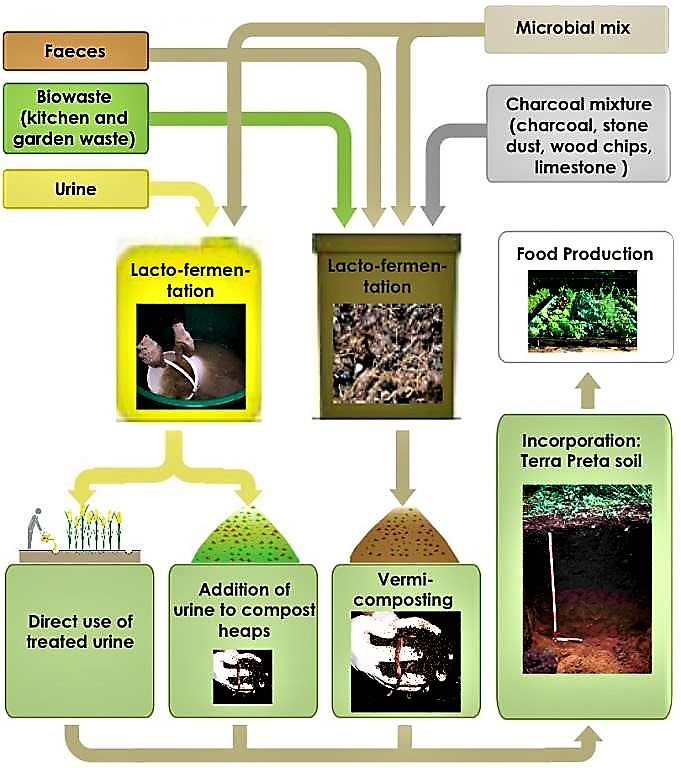
The first step in terra preta sanitation (TPS) is lactic acid fermentation (or lacto-fermentation), followed by a second step of vermicomposting (OTTERPOHL 2009). Charcoal can be added either before or after the lacto-fermentation process.
Vermicomposting is an established process for treatment of organic solid wastes or faecal matter (FACTURA et al. 2001), but the initial silage process makes the combination superior than other combined processes. This is because the flora (microbial community) of human faeces is not really compatible with soil metabolism and the microbial mix used for lacto-fermentation aids the transition to the soil life (RECKIN 2010). Lactic acid fermentation is used throughout the world in industry to preserve foods. When the acidity rises due to lactic acid fermenting organisms, many other pathogenic microorganisms are killed (http://en.wikipedia.org/wiki/Lactic_acid_fermentation). Yogurt and sauerkraut are some of the most famous products produced by lacto-fermentation and it is the lactic acid, which gives these products their slightly sour taste.
Up to date TPS has been scientifically established for kitchen and garden wastes, human faeces and human urine (OTTERPOHL 2009; OTTERPOHL n.y. a; OTTERPOHL n.y. b; FACTURA et al. 2010). Kitchen- and garden wastes are sufficient to produce the rich vermicompost to be introduced into the soil (SCHEUB 2010), but as a sanitation system, however, the co-treatment with lacto-fermented toilet products is perceived as sustainable sanitation solution (see also the terra preta toilet factsheet). Up scaling of TPS and the application to sieved blackwater, faecal sludge, sewage sludge or organics waste may be developed in the future.
Lacto-fermentation and biological mix
Lacto-fermentation is similar to the silage production process in agriculture (OTTERPOHL 2009). It is a biological anaerobic process (like anaerobic digestion), but no gas is produced (OTTERPOHL 2009). However, lactic acid bacteria have the advantage not to be sensitive to O2 (they are aerotolerant) allowing them to grow in its presence as well as in its absence (MADIGAN et al. 2003). During lacto-fermentation sugars such as glucose, fructose, and sucrose, are converted into cellular energy and the metabolic by-product lactate (http://en.wikipedia.org/wiki/Lactic_acid_fermentation). The two most important subgroups of the lacto-fermentation and lactic acid bacteria lies in the nature of the products formed from the fermentation of sugars: One group, called homofermentative, produces a single fermentation product, lactic acid, whereas the other group, called heterofermentative, produces other products, mainly ethanol and CO2 as well as lactate (MADIGAN et al 2003).
The main advantages of lacto-fermentation are that it works efficiently and stable without air exchange; produces no offensive odours; and prevents losses of nutrients or carbon to the atmosphere. Especially the treatment of urine by lacto-fermentation is interesting as the controlled metabolisation prevents the hydrolysis of the urea and its transformation to volatile ammonia and CO2, which would result in the loss of nitrogen and CO2 into the atmosphere and bad odour (RECKIN 2010; GENSCH 2010 b).
The effective mixture of microorganisms needed for the lacto-fermenting process is available commercially. But the mix is often expensive and spoils after some weeks as they are manipulated for commercialisation. The easiest way to obtain an effective microbial mix is probably to take an inoculum from Sauerkraut (pickled sour cabbage) liquid (OTTERPOHL 2009; FACTURA et al. 2010). Dr. Reckin, a German researcher, who is involved since the beginning in TPS has developed a microbe mixture similar to the so-called Effective Microorganisms (EM), containing a mixture of five microbes namely: Bacillus subtilis, Bacillus mesentericus, Geobacillus stearothermophilus, Azotobacter croococcum and Lactobacillus sp., respectively. This mixture is specifically designed to prepare for vermicomposting and thus may be better suited than commercial effective microorganism or Sauerkraut liquor. The mix is available with him, at the Technical University Hamburg-Harburg (TUHH, Institute of Wastewater Management and Protection, aww, Germany) or from the Xavier University SuSan Center (Philippines).

The recently developed urine diversion terra preta toilets (see also terra preta toilet factsheet) are based on the separate collection and treatment of faeces and urine: The urine is collected in a Jerrican that contains the microbial mix (about half a litre of microbial mix per 20 litre Jerrican) and faeces fall by gravity into a bucket that is placed airtight underneath the toilet. The faeces are then covered with the charcoal mix in order to remove the bad odour of the faeces and providing stable organic matter for the terra preta soil production (OTTERPOHL n.y. b). The mix should contain charcoal (black carbon), stone dust, finely cut wood (or another bulking agent and to raise the C/N ratio necessary for vermicomposting) and some limestone or volcanic soil (FACTURA et al. 2010; GENSCH 2010). The microbial mix for lacto-fermentation is either added together with the ash after each defecation or after the bucket is full and removed from the toilet.
In TPS systems, lacto-fermentation should be done for 4 weeks minimum before vermicomposting (OTTERPOHL n.y. b; FACTURA et al 2010).
Vermicomposting
Vermicomposting is an aerobic decomposition process involving the combined action of earthworms and microorganisms. In TPS, lacto-fermented urine, faeces and kitchen- and garden wastes (optionally lacto-fermented) can all be vermin-composted together either in a closed composting chamber (Rottebehälter) or in open vermicompost heaps. If the charcoal mixture hasn’t been added yet, it can be added now to the compost chamber or heap. The addition of charcoal is very important as it is the key factor for the black carbon content in terra preta soils, the soil structure (air, water retention), its fertility and the abundance of microbial life.
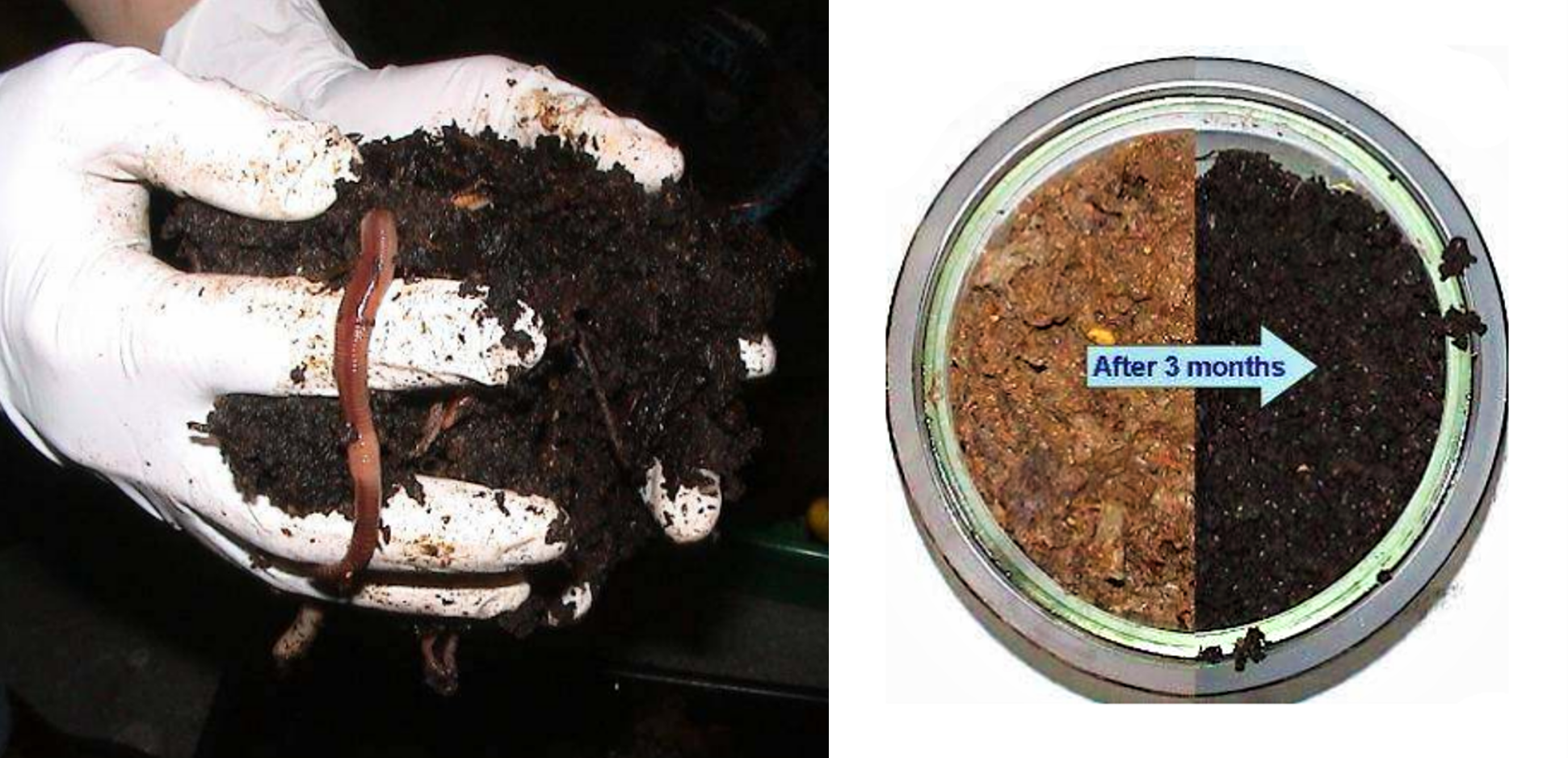
In the case of existing composting pits or heaps, worms might not need to be added as the new material is just spread over the existing compost. For a new vermicompost, worms need to be added to the material and acclimated. Once installed, the worm population is self-regulating and will increase to the point where available food and space constrain further expansion. The digestion of the earthworms accelerates the decomposition of organic matter in comparison to conventional composting (FACTURA et al. 2010).When you dig in the heaps, you will see big healthy worms (doing vermicomposting process) transforming the bio-wastes into the nutrient-rich terra preta (OTTERPOHL n.y. b). The earthworm castings (the material produced from the digestive tracts of worms) transform the nitrogen (N), phosphorus (P) and potassium (K) and the organic matter into humic acids and other matter, which improves the fertility and structure of the soil.
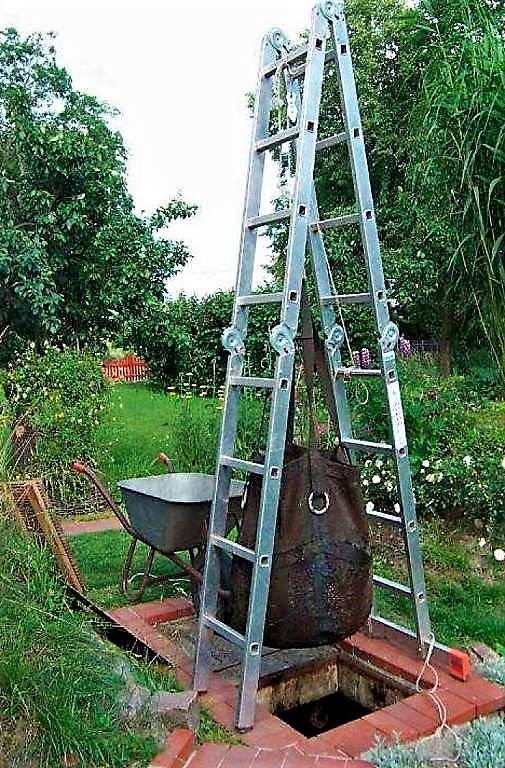
Both lactic acid fermentation and vermicomposting need to be monitored but are not labour-intensive. For vermicomposting, the main parameters to control are moisture content and temperature.
The microbial mix can be kept at the household level and continuously fed and cultivated. Generally the bacteria can be duplicated every 2 days, but they should be fed at least once a week with some water, a sugar source (blended bananas, sugar can juice etc.) and sterilized milk (GENSCH 2010 b). Sugar content in the solution should be around 3 to 5 % (GENSCH 2010 b). The entire solution should be cooked for sterilization and cooled down before added (GENSCH 2010 b). Bottles, containing the microbial mix have to be clearly labelled and kept away from children.
The lacto-fermentation process should be maintained at least for one month (up to six month, OTERRPOHL n.y. a; FACTURA et al. 2010) in a completely close container before transferring the products to the vermicomposting, where they should stay for three to six month (OTTERPOHL n.y. a; FACTURA et al. 2010).
TPS is, even though rediscovered from ancient cultures, a rather new technology and still some research is needed for exact estimation of pathogen removal. However, lacto-fermentation is used throughout the world in industry to preserve foods (pathogenic microorganisms are killed when acidity rises) and vermicomposting is a rather well established treatment of kitchen and garden wastes. A recent publication indicates that lacto-fermentation followed by vermicomposting can also be effective for excreta sanitation and leads to over 99% reduction of faecal indicator bacteria in faecal matter (FACTURA et al. 2010). The effect on other more persistent pathogens in faeces like helminth ova (Ascaris lumbricoides) still requires further research.
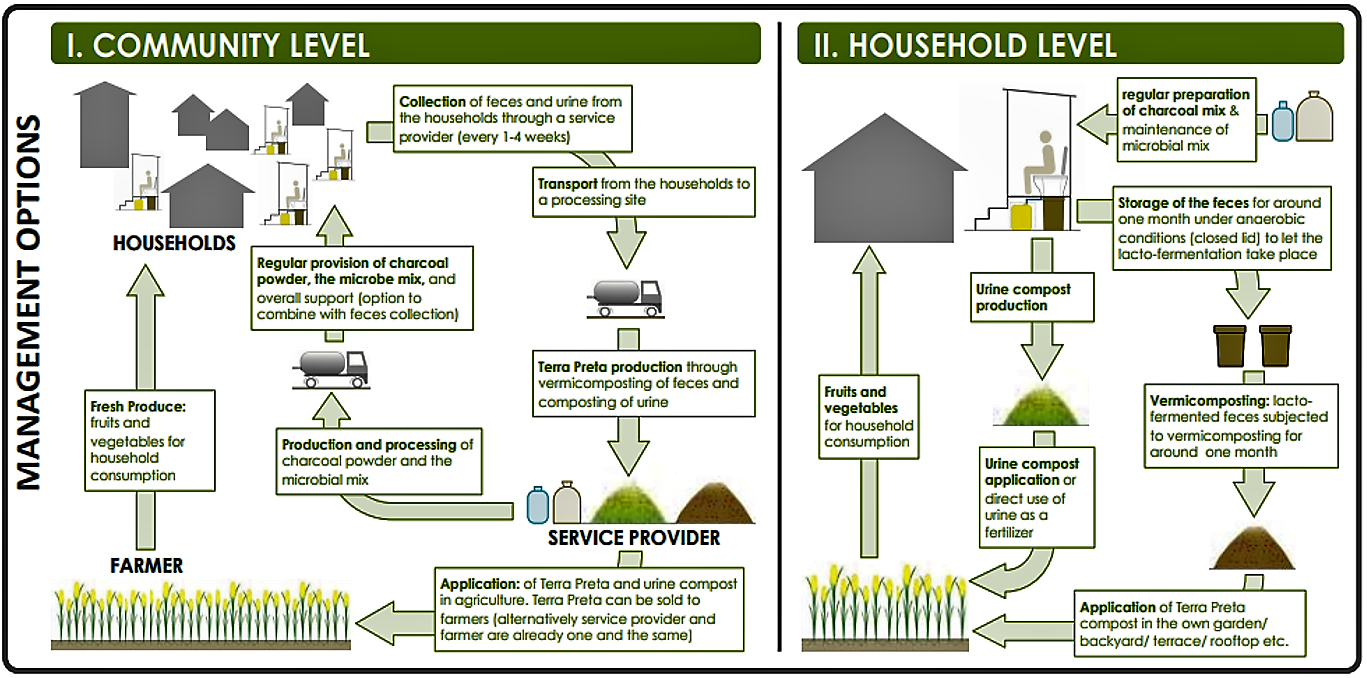
| Working Principle | Kitchen- and garden wastes, human faeces and human urine are treated in a two-step process of lacto-fermentation (a biological anaerobic process without gas production) followed by vermicomposting (composting enhanced by the digestion of earthworm). A charcoal mix (containing different materials including wood chips) is added to the compost to improve the C/N ration required for vermin-composting and the black carbon content which is characteristic for the amazing properties of terra preta soils (water retention, nutrient content, etc.). |
| Capacity/Adequacy | Can be used at both household and community level, urban and rural areas, and has the potential for both, high-tech and low-tech design. |
| Performance | Almost all nutrients and organic matter contained in the wastes are transformed to safe fertiliser. |
| Costs | Depending on context. Very flexible. |
| Self-help Compatibility | Can be constructed at the household level. |
| O&M | Microbe mix needs to be cultivated properly. Terra preta compost needs to be used. |
| Reliability | Still under research, but high potential. |
| Main strength | No loss of nutrients or organic matter to the atmosphere. |
| Main weakness | Still relatively new. Requires correct cultivation of microbial mix. |
Up-to-date TPS has been scientifically established for kitchen and garden wastes, human faeces and human urine (OTTERPOHL 2009; OTTERPOHL n.y. a; OTTERPOHL n.y. b; FACTURA et al. 2010). Vermicomposting is a well-established process for the treatment of organic wastes and lacto-fermentation is a widely applied technique for stabilisation of food. TPS can close regional cycles and improve hygienic conditions and soil fertility in a sustainable manner with the creation of local added value (FACTURA et al. 2010). Consequently, even though TPS is a rather young concept, up scaling and the application to other wastewaters (e.g. blackwater, sewage sludge etc.) is promising.
As the lacto-fermentation process does not produce any gases or odours, it is particularly interesting for larger scale and indoor application (in urban areas) (OTTERPOHL 2009; GENSCH 2010; FACTURA et al. 2010). The product, terra preta, can address the problems of soil degradation and food insecurity common in many areas across the world (FACTURA et al 2010). The TPS approach may also allow to address some major threats of dry sanitation (urban, sub-urban areas; multi storey houses; smell problems in the case of large-scale ventilation; OTTERPOHL n.y. b) and to design highly resource efficient houses and housing areas with added value in urban agriculture.
Terra Preta Sanitation: re-discovered from an ancient Amazonian civilisation - integrating sanitation, bio-waste management and agriculture
The objective of this study was to investigate the suitability of terra preta sanitation (TPS) systems as an alternative sanitation option. The effects of lactic-aid conditions in urine-separation dry toilets and a subsequent treatment by vermicomposting are assessed. Research focused on analysing standard chemical and biochemical properties of the toilet products to evaluate their stability and maturity, and establish nutrient status.
FACTURA, H. ; BETTENDORF, T. ; BUZIE, C. ; PIEPLOW, H. ; RECKIN, J. ; OTTERPOHL, R. (2010): Terra Preta Sanitation: re-discovered from an ancient Amazonian civilisation - integrating sanitation, bio-waste management and agriculture. Entradas: Water Science and Technology, accepted for publication: URL [Visita: 10.05.2019]a: Terra Preta Sanitation (TPS) Workshop, April 5-8, 2010
b: Terra Preta Sanitation. Overview
Comprehensive and well illustrated factsheet on how lacto-fermentation and vermicomposting can be used to produce valuable fertiliser and terra preta from urine and faeces from diversion dry toilets.
GENSCH, R. (2010): b: Terra Preta Sanitation. Overview. Cagayan de Oro: Xavier University, Sustainable Sanitation Center. [Accessed: 11.05.2010] PDFPrehistorically modified soils of central Amazonia- a model for sustainable agriculture in the twenty-first century
In this paper, it is argued that generating new terra preta sites (‘terra preta nova’) could be the basis for sustainable agriculture in the twenty-first century to produce food for billions of people, and could lead to attaining three Millennium Development Goals: (i) to combat desertification, (ii) to sequester atmospheric CO2 in the long term, and (iii) to maintain biodiversity hotspots such as tropical rainforests.
GLASER, B. (2006): Prehistorically modified soils of central Amazonia- a model for sustainable agriculture in the twenty-first century. Entradas: Philosophical Transactions of the Royal Society B: Biological Sciences: Volume 362 , 187–196. URL [Visita: 11.05.2010]The ‘Terra Preta’ phenomenon: a model for sustainable agriculture in the humid tropics
This paper gives a short overview on the historical background and the formation of terra preta in the Amazon region. The composition of terra preta and the importance of charcoal and other ingredients for the formation and their carbon sequestration capacity are discussed. There is an outlook on how to recreate this very useful and nutrient rich type of earth in a synthetic way by mentioning current sources and studies.
GLASER, B. ; HAUMAIER, L. ; GUGGENBERGER, G. ; ZECH, W. (2001): The ‘Terra Preta’ phenomenon: a model for sustainable agriculture in the humid tropics. Entradas: Naturwissenschaften: Volume 88 , 37-41. URL [Visita: 11.05.2019]Carbon sequestration for everybody: decrease atmospheric carbon dioxide, earn money and improve the soil
This paper argues that the production of terra preta by burying charcoal into their soils would open new ways for farmers and laymen to earn money (from carbon sequestration funds) and improve land fertility. This would is also avoid nutrient loss from land to sea. The paper discusses how this could be done in practice at small- and large-scale and what would be the impacts.
GUENTHER, F (2007): Carbon sequestration for everybody: decrease atmospheric carbon dioxide, earn money and improve the soil. Entradas: Energy and Environment : URL [Visita: 10.05.2010]Bacterial diversity of terra preta and pristine forest soil from the Western Amazon
The paper describes the bacterial diversity and community structures of a pristine forest soil and an anthropogenic terra preta from the Western Amazonian forest using molecular methods to identify the predominant phylogenetic groups. The survey provides a detailed analysis of the composition and structure of bacterial communities in terra preta anthrosols.
KIM, J. S. ; SPAROVEK, G. ; LONGO, R. M. ; MELO, W. J. de ; CROWLEY, D. (2007): Bacterial diversity of terra preta and pristine forest soil from the Western Amazon. Entradas: Soil Biology and Biochemistry: Volume 39 , 684-690. URL [Visita: 11.05.2019]A handful of carbon – commentary
An article on the potential of carbon sequestration by integrating charcoal (bio-char) into the soils.
LEHMANN, J. (2007): A handful of carbon – commentary. Entradas: Nature: Volume 447 , 143-144. URL [Visita: 05.06.2019]Brock Biology of Microorganisms. Tenth Edition
The Terra Preta phenomenon
The paper gives an overview on the terra preta phenomenon, the role of charcoal for this type of soil, benefits and related health aspects.
O’GRADY, R. ; RUSH, R. (2007): The Terra Preta phenomenon. Entradas: ‘Managing the Carbon Cycle’, Katanning Workshop: , 21-22 . URL [Visita: 11.05.2010]Terra Preta Sanitation- providing new options in ecosan systems
Based on the recent discovery of the bio-waste and excreta treatment of the pre-Colombian Amazonian cultures, the author points out the potential of this technique (addition of charcoal and lacto-fermenting microorganism and subsequent vermin-composting of the bio-wastes and excreta) for the further development of dry urine diversion sanitation: the terra preta sanitation (TPS)
OTTERPOHL, R. (2009): Terra Preta Sanitation- providing new options in ecosan systems. Hamburg: Institute of Wastewater Management and Protection (aww), Technical University Hamburg-Harburg (TUHH). [Accessed: 11.05.2010] PDFa: Terra Preta Sanitation- full reuse in sanitation and bio-waste-management
This presentation introduces the new and innovative concept of the addition of charcoal; lacto-fermentation and subsequent vermicomposting to treat the products of urine diversion dry toilets. The new process is inspired by the practices of the pre-Colombian culture in the Amazonian region that produced highly fertile anthropogenic soil (terra preta).
OTTERPOHL, R. (n.y): a: Terra Preta Sanitation- full reuse in sanitation and bio-waste-management. Hamburg: Institute of Wastewater Management and Protection (aww), Technical University Hamburg-Harburg (TUHH) URL [Visita: 11.05.2019]b: Waste Water Reuse in Buildings
This presentation gives an overview on different concept for ecosan in (multi-storey) buildings. The second half of the presentation introduces the concept of terra preta sanitation (TPS) as an anaerobic alternative to urine diversion dehydration toilets.
OTTERPOHL, R. (n.y): b: Waste Water Reuse in Buildings. Hamburg: Institute of Wastewater Management and Protection (aww), Technical University Hamburg-Harburg (TUHH). [Accessed: 11.05.2010] PDFNew Insights in matters of Plant Nutrition, Soil Microbes and their role in Recycling of Human Excreta and regenerating Soil Fertility
In this PDF presentation, a new way to preserve nutrient form urine and faeces (as urine diversion dry toilet products): the inoculation with a bacterial mix leading to an anaerobic lacto-fermentation process.
RECKIN, J. (2010): New Insights in matters of Plant Nutrition, Soil Microbes and their role in Recycling of Human Excreta and regenerating Soil Fertility. Germany. [Accessed: 10.05.2010] PDFDer aus Scheisse Gold macht
Article from a German newspaper on the potential of terra preta sanitation (TPS). German.
SCHEUBE, U. (2010): Der aus Scheisse Gold macht. Entradas: Die Tageszeitung (TAZ): URL [Visita: 11.05.2010]Language: Spanish
Compendium of Sanitation Systems and Technologies
This compendium gives a systematic overview on different sanitation systems and technologies and describes a wide range of available low-cost sanitation technologies.
TILLEY, E. LUETHI, C. MOREL, A. ZURBRUEGG, C. SCHERTENLEIB, R. (2008): Compendium of Sanitation Systems and Technologies. Duebendorf, Switzerland: Swiss Federal Institute of Aquatic Science and Technology (EAWAG) and Water Supply and Sanitation Collaborative Council (WSSCC) URL [Visita: 15.02.2010] PDFTerra Preta. Magic Soil of the Lost Amazon
This article provides detailed information on terra preta, the historical background and the latest ideas and theories of creating a synthetic terra preta.
BALLIETT, A. (2007): Terra Preta. Magic Soil of the Lost Amazon. Entradas: Acres U.S.A. The Voice of Eco-Agriculture: Volume 37 , 16-18. URL [Visita: 11.05.2019]Development of Synthetic Terra Preta (STP): Characterisation and Initial Research Findings
Poster presentation on initial research findings on the development of synthetic terra preta that could be as effective in promoting plant growth and in sequestering carbon as terra preta.
CHIA, C. H. ; JOSEPH, S. D. ; MUNROE, P. ; LIN, Y. ; HOOK, J. ; SHASHA, A. ; ZWIETEN, L. van ; KIMBER, S. ; COWIE, A. ; SINGH, B. ; LEHMANN, J. ; HANLEY, K. ; BLACKWELL, P. ; CARTER, E. ; MANNING, D. A. C. ; FIALIPS, C. I. A. (2009): Development of Synthetic Terra Preta (STP): Characterisation and Initial Research Findings. Entradas: Proceedings of the Asia Pacific Biochar Conference 2009, Gold Coast Australia 17 to 20 May, 2009. Australian and New Zealand Biochar Researchers Network: URL [Visita: 05.06.2019]Terra Preta Sanitation: re-discovered from an ancient Amazonian civilisation - integrating sanitation, bio-waste management and agriculture
The objective of this study was to investigate the suitability of terra preta sanitation (TPS) systems as an alternative sanitation option. The effects of lactic-aid conditions in urine-separation dry toilets and a subsequent treatment by vermicomposting are assessed. Research focused on analysing standard chemical and biochemical properties of the toilet products to evaluate their stability and maturity, and establish nutrient status.
FACTURA, H. ; BETTENDORF, T. ; BUZIE, C. ; PIEPLOW, H. ; RECKIN, J. ; OTTERPOHL, R. (2010): Terra Preta Sanitation: re-discovered from an ancient Amazonian civilisation - integrating sanitation, bio-waste management and agriculture. Entradas: Water Science and Technology, accepted for publication: URL [Visita: 10.05.2019]Prehistorically modified soils of central Amazonia- a model for sustainable agriculture in the twenty-first century
In this paper, it is argued that generating new terra preta sites (‘terra preta nova’) could be the basis for sustainable agriculture in the twenty-first century to produce food for billions of people, and could lead to attaining three Millennium Development Goals: (i) to combat desertification, (ii) to sequester atmospheric CO2 in the long term, and (iii) to maintain biodiversity hotspots such as tropical rainforests.
GLASER, B. (2006): Prehistorically modified soils of central Amazonia- a model for sustainable agriculture in the twenty-first century. Entradas: Philosophical Transactions of the Royal Society B: Biological Sciences: Volume 362 , 187–196. URL [Visita: 11.05.2010]The ‘Terra Preta’ phenomenon: a model for sustainable agriculture in the humid tropics
This paper gives a short overview on the historical background and the formation of terra preta in the Amazon region. The composition of terra preta and the importance of charcoal and other ingredients for the formation and their carbon sequestration capacity are discussed. There is an outlook on how to recreate this very useful and nutrient rich type of earth in a synthetic way by mentioning current sources and studies.
GLASER, B. ; HAUMAIER, L. ; GUGGENBERGER, G. ; ZECH, W. (2001): The ‘Terra Preta’ phenomenon: a model for sustainable agriculture in the humid tropics. Entradas: Naturwissenschaften: Volume 88 , 37-41. URL [Visita: 11.05.2019]Bacterial diversity of terra preta and pristine forest soil from the Western Amazon
The paper describes the bacterial diversity and community structures of a pristine forest soil and an anthropogenic terra preta from the Western Amazonian forest using molecular methods to identify the predominant phylogenetic groups. The survey provides a detailed analysis of the composition and structure of bacterial communities in terra preta anthrosols.
KIM, J. S. ; SPAROVEK, G. ; LONGO, R. M. ; MELO, W. J. de ; CROWLEY, D. (2007): Bacterial diversity of terra preta and pristine forest soil from the Western Amazon. Entradas: Soil Biology and Biochemistry: Volume 39 , 684-690. URL [Visita: 11.05.2019]Black is the new green
Article on the potential of using slow burn agriculture and burning biomass to produce charcoal for terra preta soils and the potential of biomass pyrolysis and terra preta to contribute to carbon sequestration.
LEHMANN, J. (2006): Black is the new green. Entradas: Nature : Volume 442 , 624-626. URL [Visita: 10.05.2010]A handful of carbon – commentary
An article on the potential of carbon sequestration by integrating charcoal (bio-char) into the soils.
LEHMANN, J. (2007): A handful of carbon – commentary. Entradas: Nature: Volume 447 , 143-144. URL [Visita: 05.06.2019]Bio-Char Soil Management on Highly Weathered Soils in the Humid Tropics
This chapter discusses the potential of slash-and-char agriculture as an alternative to slash-and-burn and the effects on microbial cycling of nutrients nitrogen fixation in the soils. Focus is held on highly weathered soils in the humid tropics.
LEHMANN, J. RONDON, M. (2006): Bio-Char Soil Management on Highly Weathered Soils in the Humid Tropics. Entradas: UPHIFF, N. ; BALLl, A. ; FERNANDES, E. ; HERREN, H. ; HUSSON, O. ; LAING, M. ; PALM, C. ; PRETTY, J. ; SANCHEZ, P. ; SANGINGA, N. ; THIES, J. (2006): Biological Approaches to Sustainable Soil Systems. 517-530. URL [Visita: 05.06.2019]Bio-char sequestration in terrestrial ecosystems– a review
Detail calculations of the potential of carbon sequestration by the production of bio-char (charcoal or biomass-derived black carbon) and its application to soil is proposed to establish a sink for atmospheric carbon dioxide are given and discussed.
LEHMANN, J. ; GAUNT, J. ; RONDON, M. (2006): Bio-char sequestration in terrestrial ecosystems– a review. Entradas: Mitigation and Adaptation Strategies for Global Change : Volume 11 , 395-419. URL [Visita: 05.06.2019]Nutrient availability and leaching in an archaeological Anthrosol and a Ferralsol of the Central Amazon basin: fertilizer, manure and charcoal amendments
Soil fertility and leaching losses of nutrients were compared between a Fimic Anthrosol (terra preta) and a Xanthic Ferralsol from Central Amazonia. The potential of charcoal additions among other organic and inorganic applications could to produce similarly fertile soils as these archaeological Anthrosols is assessed. Leaching of nutrients from soils where charcoal was added was significantly lower.
LEHMANN, J. ; PEREIRA DA SILVA, J. ; STEINER, C. ; NEHLS, T. ; ZECH, W. ; GLASER, B. (2003): Nutrient availability and leaching in an archaeological Anthrosol and a Ferralsol of the Central Amazon basin: fertilizer, manure and charcoal amendments. Entradas: Plant and Soil : Volume 249 , 343-357. URL [Visita: 10.05.2010]The Terra Preta phenomenon
The paper gives an overview on the terra preta phenomenon, the role of charcoal for this type of soil, benefits and related health aspects.
O’GRADY, R. ; RUSH, R. (2007): The Terra Preta phenomenon. Entradas: ‘Managing the Carbon Cycle’, Katanning Workshop: , 21-22 . URL [Visita: 11.05.2010]b: Waste Water Reuse in Buildings
This presentation gives an overview on different concept for ecosan in (multi-storey) buildings. The second half of the presentation introduces the concept of terra preta sanitation (TPS) as an anaerobic alternative to urine diversion dehydration toilets.
OTTERPOHL, R. (n.y): b: Waste Water Reuse in Buildings. Hamburg: Institute of Wastewater Management and Protection (aww), Technical University Hamburg-Harburg (TUHH). [Accessed: 11.05.2010] PDFNew Insights in matters of Plant Nutrition, Soil Microbes and their role in Recycling of Human Excreta and regenerating Soil Fertility
In this PDF presentation, a new way to preserve nutrient form urine and faeces (as urine diversion dry toilet products): the inoculation with a bacterial mix leading to an anaerobic lacto-fermentation process.
RECKIN, J. (2010): New Insights in matters of Plant Nutrition, Soil Microbes and their role in Recycling of Human Excreta and regenerating Soil Fertility. Germany. [Accessed: 10.05.2010] PDFTerra Preta and Terra Mulata: pre-Columbian Amazon kitchen middens and agriculture fields, their sustainability and their replication
The paper provides information on the discoveries of terra preta at various regions within the Amazonas area. The different soils are explained and historical background is given. Besides characteristics of the different soil types a classification is done. Results of different studies concerning the application of the pre-Columbian Indigenous techniques for sustainable land use and field and laboratory research are provided.
SOMBROEK, W. KERN D. RODRIGUEZ, T. CRAVO, M. S. da JARBAS, T. C. WOODS, W. GLASER, B. (2002): Terra Preta and Terra Mulata: pre-Columbian Amazon kitchen middens and agriculture fields, their sustainability and their replication. Thailand: Presentation of 17th WCSS URL [Visita: 11.05.2019]Herstellung von Terra Preta bei der Umsetzung ökologischer Sanitärkonzepte
This diploma thesis describes the production of terra preta (collection, lacto-fermentation, vermicomposting) as a new sanitation concept (in german).
HESTERMANN, N. (2010): Herstellung von Terra Preta bei der Umsetzung ökologischer Sanitärkonzepte. (= Diplomarbeit ). Hamburg Harburg: Techische Universität Hamburg Harburg TUHH) URL [Visita: 11.05.2019]Ecodesign: The Bottom Line
There is no single design solution to sanitation. But there are universal principles for systematically and safely detoxifying human excreta, without contaminating, wasting or even using water. Ecological sanitation design — which is focused on sustainability through reuse and recycling — offers workable solutions that are gaining footholds around the world, as Nature explores on the following pages through the work of Peter Morgan in Zimbabwe, Ralf Otterpohl and his team in Germany, Shunmuga Paramasivan in India, and Ed Harrington and his colleagues in California.
NATURE (Editor) ; MORGAN, P. ; OTTERPOHL, R. ; PARAMASIVAN, S. ; HARRINGTON, E. (2012): Ecodesign: The Bottom Line. Entradas: Nature: International Weekly Journal of Science: Volume 486 , 186-189. URL [Visita: 19.06.2012]Terra Preta Sanitation: re-discovered from an ancient Amazonian civilisation - integrating sanitation, bio-waste management and agriculture
The objective of this study was to investigate the suitability of terra preta sanitation (TPS) systems as an alternative sanitation option. The effects of lactic-aid conditions in urine-separation dry toilets and a subsequent treatment by vermicomposting are assessed. Research focused on analysing standard chemical and biochemical properties of the toilet products to evaluate their stability and maturity, and establish nutrient status.
FACTURA, H. ; BETTENDORF, T. ; BUZIE, C. ; PIEPLOW, H. ; RECKIN, J. ; OTTERPOHL, R. (2010): Terra Preta Sanitation: re-discovered from an ancient Amazonian civilisation - integrating sanitation, bio-waste management and agriculture. Entradas: Water Science and Technology, accepted for publication: URL [Visita: 10.05.2019]a: Terra Preta Sanitation (TPS) Workshop, April 5-8, 2010
b: Terra Preta Sanitation. Overview
Comprehensive and well illustrated factsheet on how lacto-fermentation and vermicomposting can be used to produce valuable fertiliser and terra preta from urine and faeces from diversion dry toilets.
GENSCH, R. (2010): b: Terra Preta Sanitation. Overview. Cagayan de Oro: Xavier University, Sustainable Sanitation Center. [Accessed: 11.05.2010] PDFb: Waste Water Reuse in Buildings
This presentation gives an overview on different concept for ecosan in (multi-storey) buildings. The second half of the presentation introduces the concept of terra preta sanitation (TPS) as an anaerobic alternative to urine diversion dehydration toilets.
OTTERPOHL, R. (n.y): b: Waste Water Reuse in Buildings. Hamburg: Institute of Wastewater Management and Protection (aww), Technical University Hamburg-Harburg (TUHH). [Accessed: 11.05.2010] PDFa: Terra Preta Sanitation- full reuse in sanitation and bio-waste-management
This presentation introduces the new and innovative concept of the addition of charcoal; lacto-fermentation and subsequent vermicomposting to treat the products of urine diversion dry toilets. The new process is inspired by the practices of the pre-Colombian culture in the Amazonian region that produced highly fertile anthropogenic soil (terra preta).
OTTERPOHL, R. (n.y): a: Terra Preta Sanitation- full reuse in sanitation and bio-waste-management. Hamburg: Institute of Wastewater Management and Protection (aww), Technical University Hamburg-Harburg (TUHH) URL [Visita: 11.05.2019]New Insights in matters of Plant Nutrition, Soil Microbes and their role in Recycling of Human Excreta and regenerating Soil Fertility
In this PDF presentation, a new way to preserve nutrient form urine and faeces (as urine diversion dry toilet products): the inoculation with a bacterial mix leading to an anaerobic lacto-fermentation process.
RECKIN, J. (2010): New Insights in matters of Plant Nutrition, Soil Microbes and their role in Recycling of Human Excreta and regenerating Soil Fertility. Germany. [Accessed: 10.05.2010] PDFCarbon sequestration for everybody: decrease atmospheric carbon dioxide, earn money and improve the soil
This paper argues that the production of terra preta by burying charcoal into their soils would open new ways for farmers and laymen to earn money (from carbon sequestration funds) and improve land fertility. This would is also avoid nutrient loss from land to sea. The paper discusses how this could be done in practice at small- and large-scale and what would be the impacts.
GUENTHER, F (2007): Carbon sequestration for everybody: decrease atmospheric carbon dioxide, earn money and improve the soil. Entradas: Energy and Environment : URL [Visita: 10.05.2010]Terra Preta Sanitation- providing new options in ecosan systems
Based on the recent discovery of the bio-waste and excreta treatment of the pre-Colombian Amazonian cultures, the author points out the potential of this technique (addition of charcoal and lacto-fermenting microorganism and subsequent vermin-composting of the bio-wastes and excreta) for the further development of dry urine diversion sanitation: the terra preta sanitation (TPS)
OTTERPOHL, R. (2009): Terra Preta Sanitation- providing new options in ecosan systems. Hamburg: Institute of Wastewater Management and Protection (aww), Technical University Hamburg-Harburg (TUHH). [Accessed: 11.05.2010] PDFDer aus Scheisse Gold macht
Article from a German newspaper on the potential of terra preta sanitation (TPS). German.
SCHEUBE, U. (2010): Der aus Scheisse Gold macht. Entradas: Die Tageszeitung (TAZ): URL [Visita: 11.05.2010]Language: Spanish
Terra Preta - Wikipedia
The Wikipedia description of the terra preta soil.
Das Gold der Erde
This German internet page provides up to date information and knowledge on terra preta. There are various studies, publications and links to related pages available. German
Terra Preta: Modell für regionale Stoffströme
An article of the German ministry for the environment on the potential of terra preta sanitation (TPS) for regional resource management.
Institute of Wastewater Management and Water Protection (aww)
Website of the institute of municipal and industrial wastewater management (aww) at the University of Hamburg-Harburg (TUHH). Their research interest is directed towards efficient sanitation solutions that preferably produce reusable material rather than waste. The focus is both on municipal and industrial wastewaters with a view on the whole process and mass flows. This includes research on terra preta, too. See also http://www.tu-harburg.de/susan/downloads/index.html for a list of publications on sustainable sanitation.


